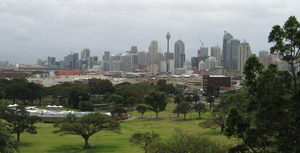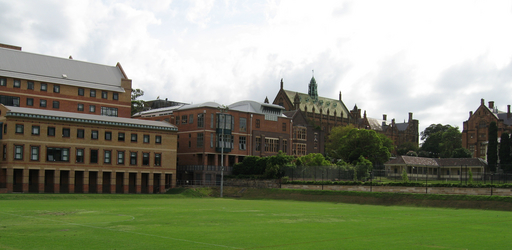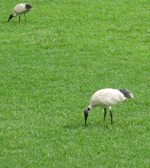|
Making a career in
Sydney, Australia
by
Hinke Osinga (University of Bristol, UK)
|
 |
| Martin
Wechselberger in his office in
Syndey |
Some of you may recall the article
"Mathematical
Biosciences Institute at The Ohio State University" that Martin
wrote for the January 2004 issue of DSWeb Magazine about the research
at MBI in Columbus,
Ohio. His postdoctoral position came to an end in 2005 and like so
many, he was trying to find a job for this academic year. Maybe
surprisingly, he opted for a permanent post at the
University
of Sydney in Australia and started in September last year. A
research trip that took your editor to Sydney created the rare
opportunity for a personal interview on site.
Who is Martin Wechselberger?
Martin was born in Austria, in one of the small
villages in the mountains where everybody is related to everybody
else. He studied mathematics at the Technische Universität Wien, in Vienna. As is custom in Austria, he stayed at this same university to pursue his PhD
research on the dynamics of singularly perturbed systems under the
guidance of Peter Szmolyan. After receiving his PhD in October
1998, he had to interrupt his research for one year for his civil
service.
While totally unrelated to mathematics, his civil
service was a very interesting experience. He worked in a camp for
Bosnian refugees. The refugee camp was established in Vienna by a
famous musician Ostbahn Kurti and was a big building housing about 30
families. The center's aim is to prepare the families for living
in Vienna; there are language courses, the center offers
professional psychological treatment and councelling for war traumas,
they train people for specific jobs, and there is an on-site
kindergarten. Martin's memories clearly travel back to this time. His
normal job was to do any hands-on tasks, help carry things,
etcetera. "As we say in Austria, I was `ein Mädchen für
alles' but one day I was asked to help out at the kindergarten. You
cannot imagine how difficult that was. These kids were completely
traumatised; they would constantly be drawing pictures about the war
and their experiences. At the same time, they were also trying me out,
like any class would do. At one time I had several kids pulling at me
and some others jumping on my back and I had no clue what to do. I just
sat there and started screaming really loudly... That helped, they
stopped and were dead silent, but I felt completely powerless.
Overall, however, it was a fantastic experience. It felt great to be
able to help these families, finding them a new flat and getting them
ready to go out into society again."
 |
|
A whole year with no
mathematics meant that it was not easy to find a job afterwards.
Fortunately, Peter Szmolyan had offered Martin a postdoctoral position
in Vienna that he could come back to. He stayed in Vienna for two more
years before taking up a three-year postdoc in the US. "My work on
singular perturbations was very theoretical. I wanted to get more into
applications and knew that models with multiple timescales were quite
common in biological applications."
|
| View of Sydney from Martin
Wechselberger's office |
|
Since Martin could not find any
programme combining singular perturbation theory with biological
applications in Europe, he started applying for postdoc positions in
the US. "From my geometric singular perturbation theory background I
knew about Nancy Kopell's Biodynamics Center in Boston. Then I found
on the internet that there was going to be a new institute in Ohio. I
had no idea where Ohio was or what it would be like, but the
scientific program presented on the MBI website
(http://mbi.osu.edu)
caught my eye."
|
Postdoc at MBI in Ohio
Martin was one of ten postdocs to start at the MBI
in August 2002. He was the only one coming from abroad. "And it
showed. I asked when I should come to start my job and they said,
naturally, that I should arrive on the first of August. However, when
I got there, I was the only one. Moreover, there was nothing there
yet, no building, no office, everything was still under construction!
The programme officially only started in September, which is when
everyone else showed up. At least I had the fun of watching the rapid
progress made to get everything ready for the first workshop in
September."
The three years in Ohio were divided into three
themes of one year each. The first year was devoted to
neuroscience. "This was a relatively established field of research and
I already knew many people who participated in this year: John Rinzel,
Nancy Kopell, Bard Ermentrout, David Terman, they were all there. I
also got to know many biologists and people who are funded by NIH. I
learnt a lot on the application side. You know, mathematicians tend to
speak in formulas, but biologist speak in abbreviations, so neither
one knows what the other is talking about!" The second year was
devoted to cell biology. "I had not expected how interesting this
research is. All the ideas that work in neuroscience can be applied
there as well!" The third year was on bioinformatics (the genome
project) and of less personal interest to Martin. It was time to start
applying for a new job.
"From my own career point of view, my move to the
US was fantastic. Within two years I had given about ten seminar talks
and met lots of people. I had several projects going and people showed
an interest in what I was doing. Those years gave an enormous
confidence boost. For example, I decided to organise mini-symposia at
the Snowbird meeting and at the SIAM Life Sciences meeting (Portland,
OR); it was great to see how big an audience these got, a mix of
mathematicians and biologists. Very quickly I had built up a
reputation and it felt natural to try to apply for a tenure-track
position." Mathematical biology is a rather popular topic at the
moment, though there are relatively few people with the right
background. Hence, as a postdoc from MBI, Martin could afford being
rather selective where to send his CV. "I mainly applied in the US,
probably because I only checked the AMS and SIAM jobs websites. Also,
the vacancies in the US tend to be advertised at least two months
earlier than in Europe."
 |
|
| The campus of the University of Sydney |
The decision to go to Sydney
Altogether, Martin applied to fewer than 25
places. Sydney was one of these, because it was advertised on the AMS
jobs listings. "The advertisement for the post in Sydney had the right
job profile. I always had some affinity for Asia, but Australia was
still missing on my map. For sure, Sydney would be a nice city. Even
though I had never been there before, I knew about it from the
Olympics. Furthermore, a big city right on the beach sounded nice;
they never told me about the blue bottles!" [Ed: Blue bottles are a
type of jelly fish with very long tentacles whose sting seriously
hurt; the number of blue bottles along the Australian coast has never
been higher than this summer.] When I checked out the University
website, I found that there were people working in mathematical
biology and also people working in dynamical systems. While they all
were in related areas, nobody worked on things that I was doing, and I
realised I could fit in very well. Admittedly, I did apply mostly out
of curiosity. However, I had met James
Sneyd in my second year at MBI. He is based at the
University of
Auckland in New Zealand and I wanted to work with him. I figured
that Sydney would bring me close enough."
A couple of weeks later,
Norman
Dancer was visiting the IMA in Minneapolis from Sydney. "He also visited
Ohio State and specifically went to my office and knocked on my door!
`Are you seriously considering coming to Australia?' he asked, and I
didn't think twice to tell him `Sure! Why not?' Then it dawned on me
that I was a serious candidate and I started to get more information
about Sydney and Australia." In particular, Martin talked to
Jack Boulant, a physiologist at Ohio State
University, with whom he collaborates on body temperature
regulation. "He told me of many people he knew in Australia who work
in this field. Especially in physiology, there are actually many Nobel
prize winners in Australia. I also found out that many authors of the
papers I had read were actually based in Australia." Indeed, Australia
does have a thriving research activity in applied mathematics and
specifically mathematical biology. The existence of
ANZIAM, the
Australia and New Zealand version of SIAM, means that there is an
active research community and Sydney is considered as one of the top
universities.
|
Martin visited Sydney for his job
interview in April 2005 and immediately fell in love with the
city. When he got offered the position, he decided to go for it. "I
did think it over very carefully and knew it was, in a sense, risky to
leave the nice environment at MBI and the US community as a whole."
Indeed, many people reacted with suprise: "How can you leave the US?"
or "How can you isolate yourself?" But with email and the internet
nowadays, it is not such a big issue anymore. "It may be easier to stay
in a known environment, but I believe that it is always better to jump
in at the deep end. This has always had a positive outcome for me: I
had ideas about research while in Europe, but these changed and I got
new ideas by moving to a different environment in the US. I expect new
ideas again, now that I moved to Sydney. It is important to be forced
to rethink what you do, especially in mathematics."
|
|
 |
| "Birds I would only see in a
zoo just walk around here on campus!" |
Sydney is the place to be
The move to Australia was in many ways
exciting, but also surprisingly easy. "It was so much easier to get
work permits and things organised for Australia compared to the
US. Australia is a true immigration country; you don't even have to be
married to bring your partner and your partner will get a work permit
as well!"
Now that Martin lives in Sydney, he has set himself
certain rules to keep his collaborations going. "I have to go to the
US and Europe once a year, and want to participate at major
conferences." Unfortunately, it is not easy to attend conferences if
you live on the southern hemisphere, because the semesters are half a
year out of phase with those in the northern half of planet
Earth. However, Martin is not so afraid of that. "I can always leave
for one week during term time if a colleague is willing to take over."
Another main reason that there are usually not many participants from
Australia at conferences is the financial support. "It is very hard to
get travel money, but people understand this when you apply and you
try to include it in a bigger personal grant application." Martin has
start-up funding, which is good for one trip to Europe, but he already
received a travel grant from New Zealand to visit James
Sneyd and Vivien Kirk at the University of Auckland. "Of
course, the university supports a visitor programme; the good thing is
that when colleagues have their summer break, they can come here, and
vice versa. This means that we can visit each other every
half year!
With several universities in Australia nearby,
Martin enjoys the exciting and active research environment in
Sydney. "My colleagues are very nice and I get along very well with
them." As a word of warning to all readers who are now dying to work
in Australia too: "The sun is different here; you do notice the hole
in the ozon layer. If it is really sunny it takes only a few hours to
get a serious sun burn. It is just like Snowbird!"